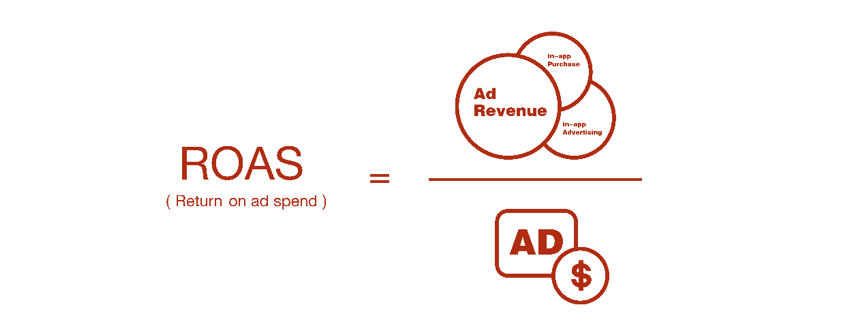Digital advertising has become the main type of marketing investment for many companies around the world, and PPC campaigns are among the most used strategies. But for these efforts to be worth investing in, the return on ad spend also needs to be positive.
To calculate how much a Google advertising campaign generated, most marketing professionals use the ROAS formula. Thanks to it, they can measure the advertising costs and other relevant information, like conversion value, and tell how good of an investment your ad groups are.
For precisely tracking ROAS, several factors must be considered, and the results you gather will directly depend on the ROAS metric information you use. If you want to know how to calculate the return generated by your Google Ads account precisely, this article is perfect for you.
We will show you how to quickly calculate the return on your ad campaigns and the revenue generated by each marketing effort. Follow all steps carefully to ensure the best results when calculating your advertising spend.
This article is a segment of a more extensive piece about Google Ads Metrics.
- What Is ROAS in Google Ads
- The Importance of ROAS Calculation
- How ROAS Can Help With SEO
- ROAS Basic Calculation
- How to Calculate ROAS for Conversion Value
- How to Improve Your Efforts and Generate Good ROAS
- Important Campaign Details Along ROAS
- Why Hiring a Professional Agency Can Maximize ROAS
- Time to Start Calculating Your ROAS
What Is ROAS in Google Ads
If you don’t know, ROAS stands for return on ad spend and is one of the key metrics used to measure the success of a digital marketing strategy based on PPC. It represents how much revenue was generated thanks to each PPC effort.
As you might think, it is based on the classic Return on Investment (ROI) calculation. It can be used to measure performance in all marketing channels, and its main objective is to show the investor the total revenue generated and how much of it is profit.
With this, marketing professionals can tell how well the campaign performed and if it was a successful investment. It can be used regardless of your PPC target objective, whether creating lead-generation campaigns or retargeting ads.
The Importance of ROAS Calculation
Creating effective marketing campaigns becomes nearly impossible without tracking and measuring ROAS (Return on Ad Spend).
Whether because it can tell the sales team how much revenue was generated through the campaign or just to analyze the number of clicks, ROAS metric helps business owners with deeper understanding of their business performance.
Along with that, another reason why looking at this data on Google Analytics is essential is because it helps the marketing team generate new insights. With this, creating new ideas that are more effective and aim at the right audience becomes way more manageable.
This is why this technique can be used whether you have a physical or e-commerce business. The most important part is to analyze the revenue based on your campaign settings and your main objective.
How ROAS Can Help With SEO
Although ROAS is mainly connected to paid ad campaigns, it can also impact your SEO efforts if you run both strategies simultaneously. For example, if you notice a bad performance on a campaign, it can mean that the keywords used are ineffective.
Since paid and organic search keywords are practically the same, you can use the ROAS to identify bad or negative keywords. Not only that, but noticing that a campaign is underperforming can mean that your target audience is not attracted to that kind of content, making it easier to create organic content that has a higher chance of being effective.
Investing in PPC and SEO simultaneously is a great strategy since pay-per-click is not organic. Once you stop paying for it, your website or social media profile drastically drops in the SERPs. Building an organic audience increases your business rank and ensures good traffic even if you stop the ad investment.
ROAS Basic Calculation

Now, it is time to see the simplest way to calculate the ROAS from an ad campaign. This is the most common way of calculating it and considers only two pieces of information.
For more complex campaign objectives and more precise evaluation of your returns, it is recommended to use other calculation methods.
This happens because ROAS only considers monetary returns. Some campaigns and businesses have other objectives when running ad groups, and for those cases, the ROAS classic calculation won’t give a precise evaluation of how good the investment was.
The basic calculation considers two base pieces of data: Total Revenue and Total Ad Spend.
With this, the final formula to calculate ROAS is ROAS = TR / TAS
If you don’t know what each information is, here is a quick explanation:
Total Revenue
As the name suggests, total revenue regards all the earnings gathered thanks to a specific ad group. The gross revenue is the overall calculation of P x Q, and its results will not be impacted by other factors like taxes, etc.
Whether working with products or services, the gross revenue will consider direct and indirect values gathered. In PPC, campaign results will go beyond just the monetary values gathered. However, when calculating ROAS through a simple calculation, information like the number of website visitors and leads generated should not be considered.
Total Ad Spend
The total ad spend or ad cost regards all values spent directly and indirectly to implement the PPC effort effectively. Everything should be noted appropriately and added to the calculation, from the initial ad value to all other costs generated along the campaign.
Managing the total ad spend goes far beyond just a step for calculating ROAS. This information also impacts the budget destined for each part of the company and is an important metric to evaluate the performance of the marketing sector.
For example, if your business spends too much on audience targeting, you might need to readjust the budget from other parts of the company. This makes the TAS calculation vital even if you’re not measuring ROAS.
How to Calculate ROAS for Conversion Value

Along with the basic ROAS formula, there are different other calculations you can make to evaluate your return on ad spend. One example is the CPC, ROAS.
The cost-per-conversion return focuses on evaluating the average conversion value of each client and whether the advertising spent to convert generated the desired results.
The formula to do it is very simple, and the only difference is that instead of using the gross revenue, you’ll use the number of conversions.
With this, the final formula will be ROAS = Total Conversion / Total Ad Spend
As we mentioned before, sometimes marketing is not aiming at maximizing the profit but at another objective, like making users complete the sales funnel. This is an example of how ROAS can be used to calculate the investment return beyond net revenue.
How to Improve Your Efforts and Generate Good ROAS

Now it’s time to see what you can do to increase your ROAS results and increase the returns earned, whether your focus is revenue, lead generation, or anything else. If you notice a low ROAS in your profit margin, make sure to take a look at these tips.
They impact your investments and many other aspects of your business. The following tips will help you increase conversion value and investment revenue when using Google Ads roas.
Review ROAS Accuracy
It is common for the average ROAS calculation to be imprecise or feature wrong information. This makes it crucial for the person responsible for calculating it to double-check every piece of information featured.
The two most common errors when evaluating ROAS are forgetting a determined item or including extra items that don’t regard the specific ad campaign. To avoid this kind of mistake, it is recommended to always list the items following a logical order, like type.
Wrong ROAS can cause the company to drop a promising PPC campaign because of inaccurate information. It is also recommended that the document gets reviewed by a second person to ensure everything is correct.
Optimize Keywords
Keyword optimization is essential for both organic and paid marketing campaigns. Choosing the right keywords can be precisely what your business needs to generate more clicks on your landing page or increase the sales volume.
The keywords you choose are directly related to a high ROAS and the quality score of your website. Make sure to conduct research and evaluate the most relevant keywords before you start paying for advertisements.
Remember that keywords are identical for SEO and PPC, so conducting proper research will benefit both techniques. It can be the key to ranking at the top of SERPs and generating more traffic to your landing pages, both organic and paid.
Moreover, conducting this research also helps you understand the target audience and what they want to see when visiting your web page. With this, you can better address the content featured and even possible new products and services to attend to the needs of this audience.
Improve Your Landing Page
Your ad might connect the user to your brand, but your landing page makes them engage with your content and complete the sales funnel. From its visuals to responsiveness, everything will impact the user’s final decision.
Conducting landing page optimization is important to all businesses, regardless of their kind. This action also impacts both PPC and SEO.
The more optimized and responsive your website is, the better ranked it will be and more likely to be shown to users even without paid ads.
One great way to improve the landing page is to keep a consistent visual ID between the ad and the page. This way, when the user clicks on the ad, it doesn’t feel like they’re being redirected to somewhere completely different.
Automate Bidding
One of the best tools available in the Google Ads console is the automate bidding function. It automatically sets specific functions and metrics based on your main objective with that ad.
Whether you want to generate more revenue for your business or increase the click-through rate, once you specify the goal, it will automatically adjust all relevant details to ensure the desired result. It is a great tool, and you save a lot of time that would be spent setting everything up.
Important Campaign Details Along ROAS

When working with Google Analytics and Ads, there is other relevant information that should be looked at other than just ROAS. Here are the main ones and what they mean:
Click-Through Rate Google Ads
The click-through rate (CTR) Google Ads is the number of clicks your ad receives when displayed to users. Looking at this information can generate insights regarding two main points: keywords and attractiveness.
If you notice your ad is not being displayed for many users or is not reaching the desired audience, it can mean your keyword choice is not performing well. This can be solved with keyword research for better-addressing campaigns.
If you notice a low number of clicks and interactions with the ad, it means that it is not attractive enough. You can either redesign the ad or change the type of paid campaign you’re running.
Cost-Per-Action
The cost-per-action (CPA) regards the average cost of each conversion you generate. The main objective of most campaigns is to generate these conversions, and the lower your CPA is, the better for your business. By knowing these numbers, you can also create more insights on how to generate both leads and conversions.
Why Hiring a Professional Agency Can Maximize ROAS

There are several reasons why hiring a professional company is recommended when creating marketing campaigns, especially PPC. The first one is ensuring all aspects of your strategy are properly aligned and will be done by a professional with experience.
Moreover, it also helps with business performance. Once you hire a company to do these tasks, you won’t need to assign them to team members, ensuring your company will run at total capacity,
At GamerSEO, we have the best professionals on the market with years of experience. By joining our family, you ensure PPC efforts are aligned with your objectives and will reach the desired results.
Not only that, but our team will work closely with you in each step of the process, from the first steps, all the way to the last results measurement. Join our team, and let’s create quality marketing together.
Time to Start Calculating Your ROAS

When running a Google Ads campaign, there are several steps and data you need to look at, and ROAS is one of the leading indicators of your campaign’s success. But for the ROAS to precisely calculate how good of an investment you’re making, everything must be precisely listed and calculated.
If your calculation isn’t precise, you might end a successful campaign or spend too much time and money on marketing efforts that are not generating positive results. To avoid that, follow several tips to double-check and ensure you gather results that reflect the real state of your campaign.
Now that you know everything you need, it is time to start calculating your target ROAS. Follow all steps and tips carefully to ensure the best results and create successful marketing actions on Google Ads.

A PPC specialist who started with organic social media. For several years, the core of his activities are:- Google Ads, Microsoft Ads, Meta Ads, TikTok Ads, Twitter Ads, Linkedin Ads. He has led campaigns with a global reach, e.g. for FootballTeam, G2A, ETOTO, as well as many smaller campaigns in the sports, construction and financial industries. Has full focus on ROAS. Privately, a fan of football, history of wars and Star Wars.

